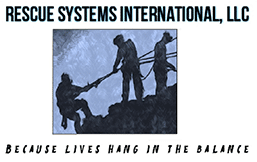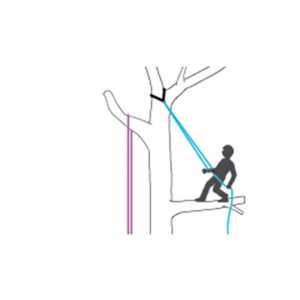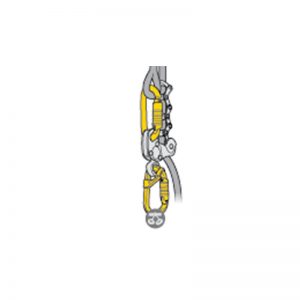For better efficiency and convenience while moving along a branch with SRT, various techniques provide the self-hauling effect that is a key benefit of DdRT techniques.
Note: in this document the name ZIGZAG means either the ZIGZAG or ZIGZAG PLUS models.
The principle is to temporarily create a fixed point on the taut rope between the arborist and the tree-top, which will function as a redirect to double the rope.
1. Recommended technique with the free rope
Advantages
- No change in protection system configuration: the effectiveness of the rope clamp used at the redirect point does not affect user safety
- The system switches to 2:1 self-hauling
- Better ergonomics when returning to the trunk because the arborist can pull on all of the rope in front of him/her, with nothing to limit stroke length.
- The non-retrievable version can be installed at any time with bodyweight on the rope, without the need to be tethered.
Disadvantages
- You must keep the free rope with you at all times while moving (e.g. by passing it through a CARITOOL on the harness). If the free rope gets away from the arborist, the self-hauling benefit is lost (without posing any specific hazard).
Variations
The redirect point can be fixed with BASIC + ROLLCLIP, it will thus be necessary to go back up to the redirect point to dismantle the setup when the work is done.
A retrievable setup is possible using the RING OPEN + ROLLCLIP or RING L + ROLLCLIP. In this case, the RING is held in place only by friction: the redirect point will stay fixed on the rope as long as it is taut, and will become movable (and thus retrievable) once the rope is slack.
Note on using the BASIC on 11.5 – 13 mm ropes:
The BASIC is designed for ropes up to 11 mm in diameter: it is not compatible with ropes that are usable with the ZIGZAG. Larger-diameter ropes can be difficult to insert into the device.
Locking performance has been verified as satisfactory.
The BASIC does not slide very well on large-diameter ropes; this is why it cannot be used in its main application (rope ascent) on ropes larger than 11 mm in diameter. In the use presented here, no sliding is required, so the BASIC may be used.
For greater efficiency, use the ASCENSION, which is compatible with ropes up to 13 mm.
2. Possible technique with the free rope and a redirect on the ZIGZAG
This technique observed in the field requires special precautions.
Advantages
- The system switches to 3:1 self-hauling.
Disadvantages
- The user must be tethered to set it up, because it is necessary to unload the rope between the ZIGZAG and the anchor, and to remove the CHICANE. So it’s not possible to set it up just anywhere.
- Ergonomics when returning to the trunk are not improved because the arborist must pull the segment of rope between him/herself and the ZIGZAG, which means a limited stroke length (unless an adjustable bridge is used to extend the ZIGZAG when returning to the trunk, as in DdRT).
Note
The retrievable version is not recommended for this technique, due to the risk of the RING OPEN slipping on the rope (undefined locking ability, dependent on rope diameter and condition, the RING’s wear state…). The system has been slow-pull tested to 4 kN without slippage, with new RING OPEN + ROLLCLIP + FLOW. No drop testing has been done on this system.
WARNING: the CHICANE must not remain in place between the ZIGZAG chain and the rope redirect point. Significant risk of the CHICANE’s handle pressing on the ZIGZAG’s release lever, which could cause a fall.
3. Not recommended technique with the free rope and a redirect on the CHICANE
This technique observed in the field is not recommended with the CHICANE.
In addition, there is a risk of breakage of the CHICANE’s plastic stopper which was not designed for this use (breakage not accepted in after-sales service).








Reviews
There are no reviews yet.